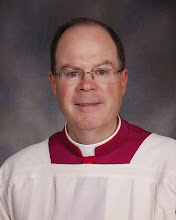Today’s feast of the Presentation
of the Lord falls on Sunday only once every seven years. Do you know what that
means? I can recycle an old homily and no-one will notice!
I fought back that
temptation, for two reasons. The first was that somebody might notice. And the
second was that nobody would notice, which would prove my 2014 homily wasn’t
memorable!
Of course those weren’t the
only reasons. I’ll tell you the big one a little later. But first, let’s take a
look at the introductory address we heard at the start of Mass. It tells us
what this feast is about, why it’s important, and what it means for us.
First, today is “the blessed
day” when Jesus was presented in the Temple by Mary and Joseph, forty days
after his birth. Of course we don’t know his actual birthday, but if you do the
math you’ll realize February 2 is forty days after December 25, when we
celebrated it.
Why is the Presentation so
important? “Outwardly,” we read, “he was fulfilling the Law, but in reality he
was coming to meet his beloved people.”
And what does it mean for us?
Because we are invited to share the experience: “gathered together by the Holy
Spirit,” the introduction says, let us also “proceed to the house of God to
encounter Christ.” The introduction thus carries us from the Temple in
Jerusalem more than two thousand years ago to Christ the Redeemer church, right
now.
Just as Simeon and Anna recognized
their Lord in the temple, so we find Jesus in this church today, recognizing
him in the breaking of the bread, the Eucharist.
That’s a lot to celebrate and
a lot to think about. But there’s more. The Presentation is the fulfillment of
an ancient prophecy. In our first reading from the prophet Malachi, we read “the
Lord whom you seek will suddenly come to his temple.” This is exactly what
happens in today’s Gospel, and both Simeon and Anna knew it straightaway.
The arrival of Christ in his
father’s house not only fulfills a prophecy but marks a turning point in the
history of our salvation. Jesus is the high priest, as we heard in the second
reading, and he has come to make a sacrifice. But not a temple sacrifice of
animals—the sacrifice of himself as victim.
Today’s psalm urges the very
gates of the temple to throw themselves open to admit the King of Glory. Of
course that’s a literary tool, called personification. The psalmist is calling
us to open the gates of our hearts to the King of Glory, the Lord—to let him in
so that he can share his glory with us.
The stakes are high. To take
just one point from the second reading, Jesus will “free those who all their
lives were held in slavery by the fear of death.” Each and every one of us, old
and young, can find the peace of heart that Simeon found when he met the
Messiah.
There’s still more to be said—about
the connection of this feast to Christmas and the Epiphany, for one thing, and
about Mary’s spiritual martyrdom, for another—but Sunday Mass-goers will have
to wait another seven years. Because there’s a second homily sitting in the
pews this morning, a living Gospel we do not want to miss.
I refer, of course, to the
members of the Gatare family. The story of these brothers and sisters of ours
are already well-known to most of you. You know how they fled Rwanda, only to
find themselves in exile for a decade in Kenya; you know how long they waited
even after our parish had officially sponsored their coming to Canada.
Today, they are with us as
symbol of suffering—a sword must have pierced their hearts many times during the
long ordeal—but also a symbol of hope. They remind us, as Simeon did, that
faith requires waiting. In our instant culture we want things now, whether it’s
fast food or freedom; but God has his own timing and we need to live our lives
by his clock and calendar, not our own.
When Jesus came into the
temple, that sacred space became holier by his presence. The same thing is
happening in our church, this morning. Jesus has come into this church today
just as he entered the temple in Jerusalem—we know this from his words “Truly I
tell you, whatever you did for one of the least of these brothers and sisters
of mine, you did for me.”
The Gatares, our brothers and
sisters, and the brothers and sisters of Jesus, come to us today as symbols of
his presence, as reminders of his salvation, and with the same gratitude to God
that Mary and Joseph had when they brought their child to the temple.
So let us rejoice together, lifting up our heads and welcoming the Lord whom we seek, the King of Glory who has come to meet his people and set them free.



No comments:
Post a Comment